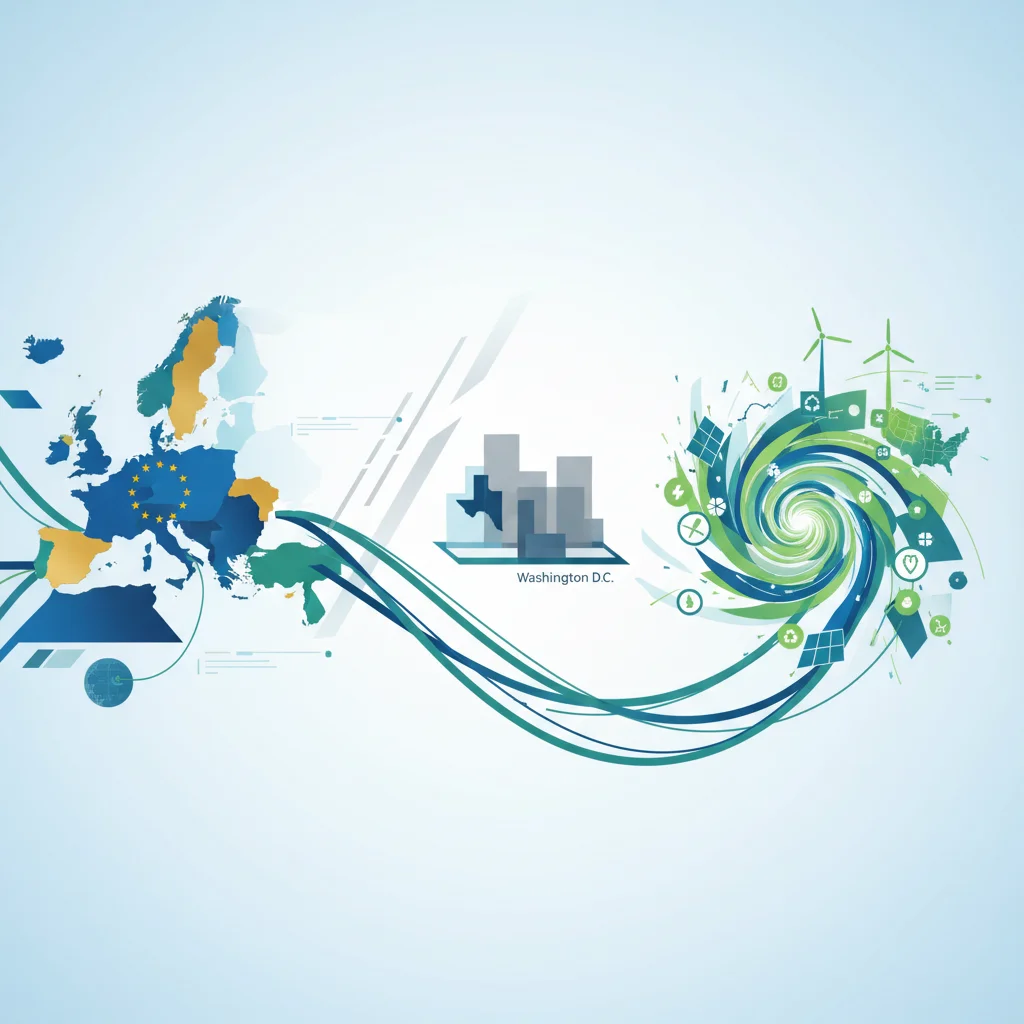
The New Climate Alliance: How the EU is Bypassing Washington to Forge a Green Economy with US States
In a bold and strategically nuanced move, the European Union is redrawing the map of climate diplomacy. Brussels is no longer waiting for a consensus from Washington. Instead, it is launching a direct charm offensive aimed at the economic powerhouses within the United States: its individual states, cities, and influential business consortiums. This pivot, as reported by the Financial Times, signals a profound shift in how global climate action will be financed, implemented, and invested in for the next decade. It’s a pragmatic recognition that in the complex world of the modern economy, power is diffuse, and progress often follows the path of least political resistance.
This isn’t just a political footnote; it’s a flashing green light for investors, finance professionals, and business leaders. The EU’s strategy to work directly with ‘subnational entities, business and think tanks’ on clean energy and climate initiatives is set to unlock a new wave of transatlantic investment, creating distinct economic ecosystems that operate with or without federal endorsement. Understanding this subnational landscape is now critical for anyone involved in finance, investing, and long-term economic strategy.
The Geopolitical Calculus: Why Sidestep Washington?
The decision to engage directly with states is a masterclass in geopolitical risk management. The fluctuating nature of US federal climate policy, which can dramatically reverse with each election cycle, presents a significant challenge for long-term capital investment. The EU, with its legally binding Green Deal and ambitious 2050 net-zero targets, cannot afford to tether its multitrillion-dollar transition to the whims of American politics. By forging alliances with states like California, New York, and Washington—entities with their own aggressive climate goals and economies larger than many G20 nations—Brussels is building a more resilient and predictable framework for cooperation.
This approach is heavily influenced by two landmark pieces of regulation on opposite sides of the Atlantic:
- The US Inflation Reduction Act (IRA): While initially viewed in Europe as a protectionist measure, the IRA’s $369 billion in green subsidies (source) has undeniably supercharged the clean energy economy in the US. The EU now sees an opportunity to partner with states to leverage this momentum, ensuring European companies can participate in and contribute to this boom.
- The EU’s Carbon Border Adjustment Mechanism (CBAM): This policy will impose tariffs on carbon-intensive imports into the EU, starting in 2026. By working with US states to align on carbon accounting and green manufacturing standards, the EU can help businesses within those states remain competitive and avoid future trade barriers. It’s a form of proactive economic diplomacy that benefits both sides.
This twin-track approach—leveraging US incentives while mitigating future trade friction—forms the core of the EU’s new strategy. It’s less about snubbing the federal government and more about building a durable, parallel track for progress grounded in shared economic interests.
Mapping the Opportunity: Key States in the New Green Economy
For investors and businesses, the critical question is: where will this capital flow? The focus will be on states that combine political will with economic scale and technological innovation. Below is a look at some of the key players in this emerging subnational alliance.
| US State | Key Climate Goal | Approx. GDP (USD) | Noteworthy Investment Areas |
|---|---|---|---|
| California | 100% zero-carbon electricity by 2045; Carbon neutrality by 2045 | $3.6 Trillion | EV Infrastructure, Battery Storage, Green Fintech, Venture Capital for Climate Tech |
| New York | 100% zero-emission electricity by 2040; 85% GHG reduction by 2050 | $2.0 Trillion | Offshore Wind, Building Retrofitting, Green Bonds, Financial Services Innovation |
| Washington | 100% clean electricity by 2045 | $725 Billion | Sustainable Aviation Fuel, Hydropower Modernization, Clean Tech R&D |
| Illinois | 100% clean energy by 2050 | $1.0 Trillion | Nuclear Energy, Solar Development, EV Manufacturing, Carbon Capture |
| Texas | Leading state in wind and solar energy production (source) | $2.4 Trillion | Wind & Solar Energy, Green Hydrogen Hubs, Grid Modernization |
This table illustrates that the opportunity is not confined to the coasts. Even states without overarching federal-style mandates, like Texas, are leaders in renewable energy production due to powerful market forces. The EU’s engagement will likely accelerate this trend, creating regional hubs of excellence that attract international capital and talent.
The Investor’s Playbook: Navigating a Fragmented but Opportunity-Rich Landscape
For the savvy investor, this fragmentation creates a more complex but potentially more rewarding environment. A monolithic, top-down federal policy creates one set of winners. A state-level patchwork, however, cultivates diverse ecosystems for growth. Here’s how to approach it:
1. Think Granular with ESG Investing
ESG (Environmental, Social, and Governance) analysis must evolve. Instead of simply looking at a company’s national headquarters, investors should assess its operational footprint within these proactive green states. A company with significant assets in California or New York’s renewable energy sector has a different risk and opportunity profile than one concentrated in a state with less ambitious climate policies. This subnational diligence will become a key differentiator for successful ESG-focused funds.
2. The Rise of Municipal and Green Bonds
To fund their ambitious infrastructure projects—from offshore wind farms to modernized electrical grids—states and cities will increasingly turn to the bond market. This will fuel a boom in municipal green bonds. For fixed-income investors, these instruments offer a chance to fund tangible climate solutions while earning stable returns. The global green bond market is already substantial, having surpassed $2 trillion in cumulative issuance, and this EU-US state-level collaboration will only add to its depth and appeal for the institutional banking sector.
3. Sector-Specific Opportunities
The EU-US alignment will create targeted growth in several key sectors:
- Clean Energy & Grid Tech: Beyond solar and wind, this includes battery storage, smart grid technology, and green hydrogen.
- Sustainable Agriculture & Biofuels: States in the Midwest offer significant potential for collaboration on low-carbon farming practices and next-generation biofuels.
- Fintech for Climate: There is a growing need for financial technology platforms that can verify green credentials, manage carbon offsets, and channel retail investment into climate projects.
– Electric Mobility: Investment will flow not just to EV manufacturers but to the entire supply chain, including charging infrastructure, battery recycling, and software management systems.
Risks and Ripple Effects on the Global Stock Market
This strategy is not without its challenges. A primary risk is regulatory fragmentation. Companies operating across the US may face a dizzying patchwork of standards, increasing compliance costs. There is also the potential for political friction between state and federal governments, which could create uncertainty for projects. This dynamic could lead to increased volatility in the stock market for companies heavily exposed to these state-level policies.
Furthermore, this move could have significant ripple effects on international trade and supply chains. As the EU and certain US states align their green standards, they may effectively create a “green trade corridor.” Companies within this corridor will benefit from streamlined market access and lower carbon-related tariffs. Those outside of it, however, could find themselves at a competitive disadvantage. This will force a strategic realignment for multinational corporations, influencing decisions on where to build factories, source materials, and invest in R&D.
The world of international economics is being subtly re-shaped, not by a single grand treaty, but by a series of pragmatic, economically-driven handshakes between Brussels and state capitals like Sacramento and Albany.
Conclusion: A New Chapter in Transatlantic Relations
The European Union’s decision to engage directly with US states on the green agenda is far more than a diplomatic curiosity. It is a clear-eyed strategy to de-risk its climate ambitions and tap into one of the world’s most dynamic innovation and investment hubs. It represents a shift from rigid, top-down international agreements to a more flexible, multi-track approach built on shared economic incentives.
For those in the worlds of finance, business, and technology, the message is clear: the future of the green transition is both global and local. The most significant opportunities may not be found in the halls of Washington D.C., but in the bustling economic ecosystems of America’s most forward-thinking states. By understanding this new map of influence and investment, stakeholders can position themselves at the forefront of a cleaner, more prosperous, and profoundly interconnected global economy.

